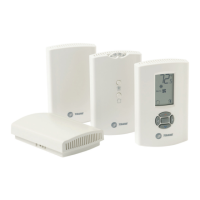BAS-SVX04C-EN • Wireless Sensors 31
Operation
Receiver Power-up Sequence
When power is applied to the receiver, one of the following sequences occurs. The
sequence is dependent on the address setting and the association status of the receiver.
Address set to 000 and receiver is not associated with a sensor
• LED5 is constantly On, indicating power is applied and the receiver is functional.
• All models: Zone temperature and cooling setpoint default to 72.5°F (22.5°C).
WDS only: The heating setpoint defaults to 70.5°F (21.4°C) and the fan/system
output will be 2230 Ω (see “Output Values—Failure and Default Modes of
Operation,” p. 44).
• Status LED3 will display a 2-blink pattern diagnostic (Table 3, p. 36).
Address set from 001 to 999 and receiver is not associated with a sensor
• LED5 is constantly On, indicating power is applied and the receiver is functional.
• All models: Zone temperature and cooling setpoint default to 72.5°F (22.5°C).
WDS only: The heating setpoint defaults to 70.5°F (21.4°C) and the fan/system
output will be 2230 Ω (see “Output Values—Failure and Default Modes of
Operation,” p. 44).
• The receiver conducts an energy scan for 20 seconds to determine the clearest
channel on which to operate.
• LED3 flashes On every 2 seconds when it is ready to accept a sensor association
request. When an association request is made by a sensor, the receiver instructs
the sensor on which power level to operate. Then the receiver and sensor begin
operation at the appropriate channel and power level (see “Observing the Receiver
for Readiness to Associate,” p. 18).
Address set from 001 to 999 (and not changed since most recent power-up)
and receiver is associated with a sensor
• LED5 is constantly On, indicating power is applied and the receiver is functional.
• Zone temperature and setpoint default to 72.5°F (22.5°C). WDS only: Heating setpoint
defaults to 70.5°F (21.4°C), Fan = Auto, System = Off.
• The receiver waits for a broadcast transmission from its associated sensor. When a
transmission is received, the receiver positions its zone temperature and setpoint
outputs appropriately.
• If the receiver does not receive a communicated signal from its associated sensor
within 35 minutes, zone temperature and setpoint outputs fail, generating a unit
controller alarm (see “Output Values—Failure and Default Modes of Operation,”
p. 44).
Note: Once a receiver communicates to a WTS sensor, the receiver disables (opens)
its zone setpoint output indefinitely.

